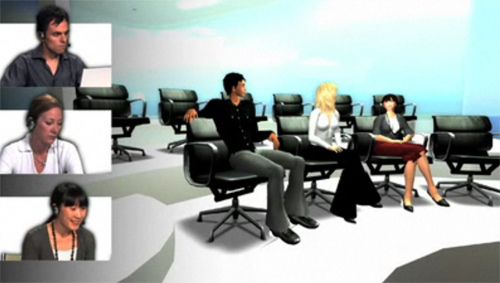The longer it takes you to catch on, the more visionary I get
Take a look at the wonderful, terrible Immersive Workspaces from Linden Lab and Rivers Run Red.

[With apologies to Bruce Sterling]
Take a look at the wonderful, terrible Immersive Workspaces from Linden Lab and Rivers Run Red. Wonderful because it’s a great piece of work and a real breakthrough, but also wonderfully terrible. That is, if its goal is as stated “a complete collaboration solution”, and “the ultimate destination in real-time collaboration”.
You see, what they’ve built looks like a great solution for real-time communication and coordination – but that’s not the same thing as collaboration. Let’s take a look. I’ll wait here while you watch the video.
The system provides the following task-oriented headings: News, Team, Meetings, Actions, Media, Journal, Stats, Admin, and Go 3D. This is looking like the next generation of groupware, with that last link promising a sprinkle of social avatar-chat sugar on top, courtesy of Second Life.
The use case shown is called a “collaboration session” – but let’s look at what the participants (Laura, Adam and Sakura) actually do.
- Laura and Adam don headsets, sit down at PCs and log on. They can now talk to each other and see their avatars.
- Their avatars enter a virtual presentation room, with chairs oriented toward a representation of a projection screen.
- Sakura’s avatar appears, joining the chat: “Sorry to keep you waiting. I’ve just uploaded my slides for us to take a look at”.
- The avatars appear to look at the slides and discuss them.So far we have communication. Note that the “real work” – preparing and uploading the slides – was done before entering the virtual world.
- Adam is asked to add something to the presentation. He exits the virtual world, from his point of view: he’s now working full-screen on the presentation while his avatar stays in the virtual room.
- Now the magic – Adam’s changes appear on the projection screen within the virtual presentation room.Here we have something new – a moment of actual collaboration. However note that if Sakura and Laura wanted to join Adam in editing the presentation they would both have to exit the virtual world as well, moving over to screen sharing.Now we return to the virtual world, and with it we shift back from collaboration to coordination.
- Laura approves the changes, and directs Adam and Sakura to perform various tasks outside the virtual world. In the video we can see them nod their heads in assent – invisibly to Laura, though.

Taken as a whole then, Immersive Workspaces is a collaboration solution. It’s interesting to see the dividing lines emerge: Communication takes place in the virtual world, collaboration in the bundled screen-sharing application, and everything’s coordinated in the bundled groupware.While in the immersive virtual world participants ignore the real world. When they leave it to use something else (like screen sharing) they maintain the sense of shared place by pretending that they’re still there.
The design of the virtual environment reinforces this implicit division; it’s a seminar room. The slides are up on a presentation screen, to be shown rather than collaboratively manipulated. All this is ideal for communicating ideas but it’s not a place that particularly affords active collaboration.
I think there are other designs that can remove this divide, and the focus on immersion is in the way of realising those designs. On this blog I hope to show you what I mean.
